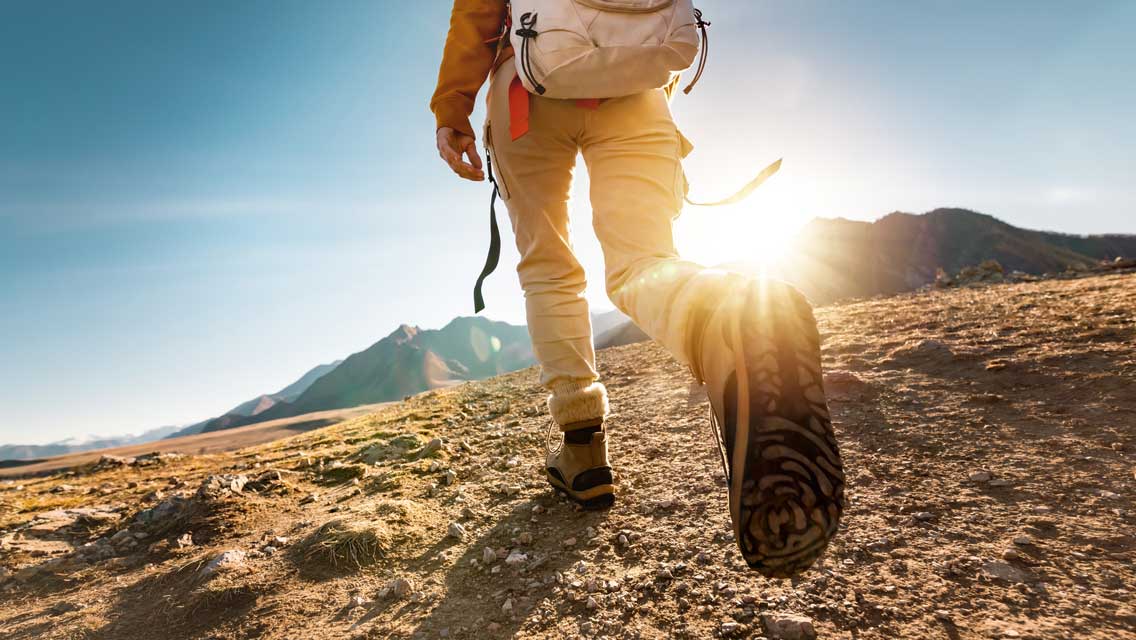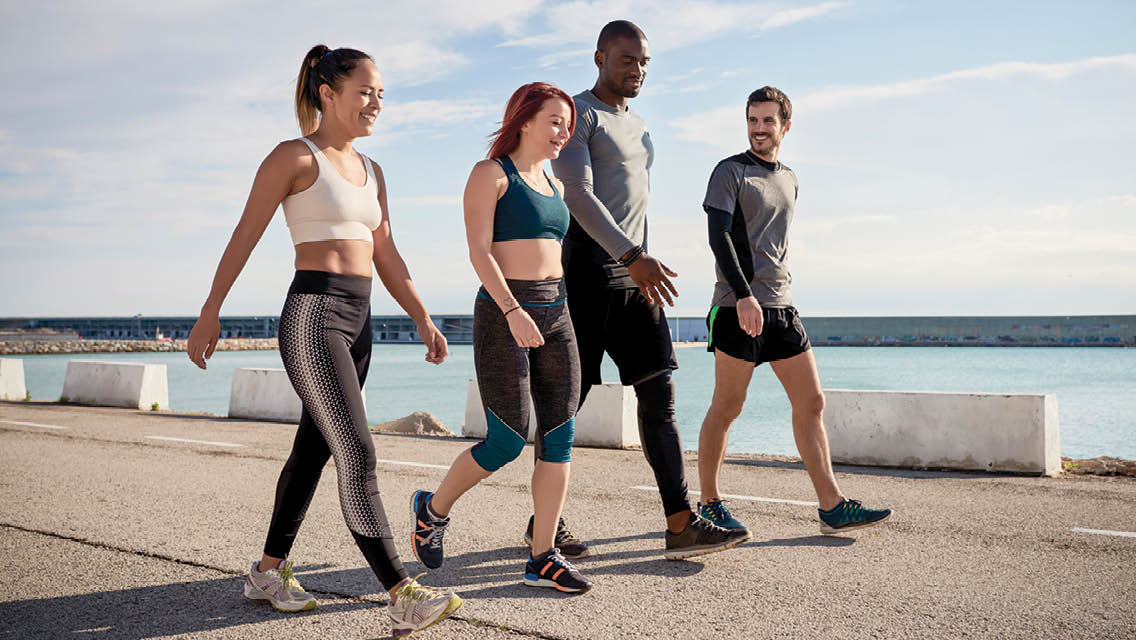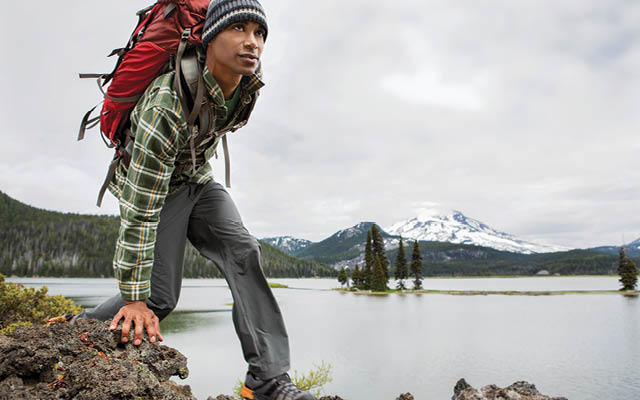The summit of Vermont’s Mount Philo, with its views of the sparkling Lake Champlain, is one of the most popular outdoor destinations in the state for a reason: Its short, roughly three-quarter-mile ascent is relatively easy — an accessible climb for hikers, picnickers, families with young children, and nature enthusiasts of all types.
Mount Philo was an ideal location for one of my early attempts at rucking — walking with weight, usually in the form of a pack known as a rucksack. While the exercise has long been used in military training and is now a central feature of endurance events like GORUCK Challenges and others, rucking is hardly reserved for elite athletes or special forces. As Steph Gaudreau, CISSN, NASM-CPT, a San Diego–based fitness coach and avid rucker, says, “We were all rucking when we walked to school with our backpacks on.”
And so I loaded 25 pounds onto my back, strapped my iPhone to my arm — with Prince cued up on my playlist — and began what would normally be an easy, breezy amble up the hill.
It took almost no time before the added weight made its presence known. My heart pounded. My glutes were firing. A Mount Philo State Park ranger eyed me with a mix of suspicion and concern. I assured him I was just working out.
And what a workout rucking is!
“Rucking improves cardio and lung capacity, strengthens your core and glutes, and improves both walking and running speeds when you’re not wearing a ruck,” says Amy Petersen, director of programming and operations at the online PATHFINDER Ruck Training. “It’s amazing how much lighter you feel and faster you are when you take the weight off.”
“Rucking improves cardio and lung capacity, strengthens your core and glutes, and improves both walking and running speeds when you’re not wearing a ruck.”
Additionally, says Charlie Bausman, chief operating officer at the Mountain Tactical Institute in Missoula, Mont., “[rucking] can be a low-impact method for improving general fitness and training for uphill movement.”
As Bausman points out, rucking is infinitely adjustable based on weight, speed, terrain, and distance, making it possible to start slow and ramp up as your fitness improves and interest soars. By continually pushing you up against the edges of your comfort zone, rucking can help build resilience — physically and mentally. (Personally, I went on to train for and complete a GORUCK Heavy, a gritty team-adventure event that called for carrying weighted rucksacks for 40-plus miles. You can read all about that experience here.)
Even if competitive rucking isn’t your thing, incorporating weighted walks into your training can improve functional strength for everyday activities by building up your core and postural muscles and improving muscular endurance in the lower body.
Plus, rucking provides a social opportunity. Online communities and in-person clubs abound, making it possible to meet like-minded people — ruckers will often seek partners for safety and companionship while exploring new terrain — and even ruck as a team.
Want to give this activity a try? Experts share their best tips to help you pack up and step out for a strength-building walk.
One Step at a Time
Ready to ruck? Bausman offers the following best practices:
- “Start slow and light,” he says. For a rucking rookie, he recommends a pack weight of 15 to 25 pounds and advises walking at a normal pace for the first one to two miles.
- Build up on distance first. A rule of thumb for many endurance endeavors is to increase mileage by about 10 percent each week, though some people find that to be conservative. Heed your body’s signals and make time for recovery as you navigate the right distance increases for you.
- Once you can complete five miles, begin increasing your pace. For most people, a “fast” walking speed is in the 4 to 5 mph range. As your pace increases, you may choose to shift from walking to shuffling or jogging, though that is not a requirement of rucking.
- Pack weight should be the last thing to increase — and should only be increased gradually. Consider adding five pounds every few weeks, and keep in mind that most people, outside of military athletes and mountain athletes, are not advised to carry more than 35 pounds, says Bausman.
- You can ruck anywhere. But, as Bausman notes, “trails are preferred over roads or sidewalks to reduce the impact on the joints.”
- As for how often to ruck, one to two times a week is plenty.
Finally, Petersen adds, don’t overthink it. You can start rucking right from your front door. Choose a familiar route, and begin with your most comfortable, conversational pace. Simple ways to rack up mileage include putting your rucksack on while walking the dog in the evening, or rucking to the gym, office, or grocery store.
“Our participants who do our hardest programs tend to do shorter miles more consistently,” says Petersen. “Because rucking is so easy to do, the only way to do it wrong is to not do it at all.”
Take a Load On
Gaining unilateral strength and absorbing force are key components of rucking development. “Even if you’re stepping off a curb, your body has to be good at decelerating and absorbing impact,” says Gaudreau. To help prepare and support your body through the rigors of rucking, she suggests working step-ups and step-downs into your strength routine.
Step-Up
Repeat 12 times on the left, then switch sides.
- Stand facing a box or a step. Raise your left foot off the floor and place it flat on the box, making sure your heel is not hanging off.
- Engage your core and shift your weight onto your left foot. Drive through your left heel to come to standing on the box.
- With control, reverse the movement, returning your right foot to the floor.
Make it easier: Use a shorter step. Hold on to a rack or similar sturdy object for assistance, as needed.
Make it harder: Hold a dumbbell or a kettlebell in one or both hands, or wear a weight vest or weighted pack.
Step-Down
Repeat 12 times on the left, then switch sides.
- Stand on top of a box or a step so that your left foot is planted firmly and your right foot is hanging off the back.
- Engage your core and with control, bend your knees and lower your hips. Take care to keep your hips level as you squat down.
- Lower yourself until the toes of your right foot gently tap the floor. (Make sure to keep your weight on the left foot; do not shift it back and lower yourself onto the right foot.)
- Return to standing, making sure you don’t push off the right toes for assistance.
Make it easier: Use a shorter step. Hold on to a rack or similar sturdy object for assistance, as needed.
Make it harder: Hold a dumbbell or a kettlebell in one or both hands, or wear a weight vest or weighted pack.
Rucking Essentials
Shoes:
Footwear is a highly personal choice, and experts recommend getting fitted at a local outdoor store. Look for sturdy, supportive shoes or boots that feel good while wearing your ruck, which you should bring with you while selecting the right pair. Your feet should be snug but still have room, as they will swell while rucking.
Rucksack:
While any backpack can be used for rucking, the ideal rucksack will feature a supportive structure made of durable fabric as well as shoulder padding for added comfort. Both Gaudreau and Petersen recommend GORUCK rucksacks as they are specifically designed for rucking and have sleeves into which weight plates easily slip. Think of your rucksack as a turtle shell, with the weight carried high and snug to your spine. “Keep everything close and compact,” says Gaudreau. “If you like rucking, it’s a bit of an investment to get a bag made for the purpose, but it’s going to be much more comfortable, and you’re going to like rucking even more.”
Load:
Many beginning ruckers choose household items as their starting weight: books, dumbbells, clothes, even a cast-iron skillet or glass water bottles wrapped in towels. GORUCK sells cast-iron weight plates. Remember to start light.
Safety:
Make sure to pack a first-aid kit and a change of socks. If you’re rucking in the dark, take a headlamp and a reflective vest.





This Post Has 0 Comments